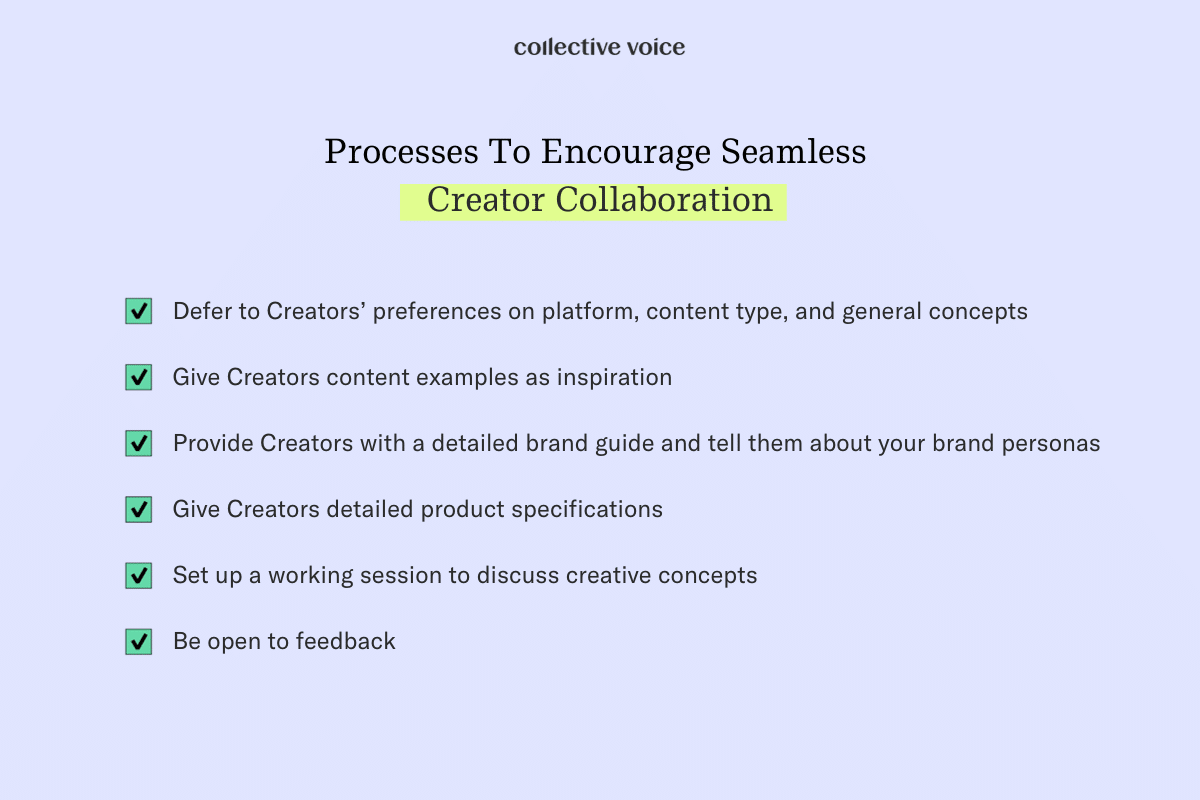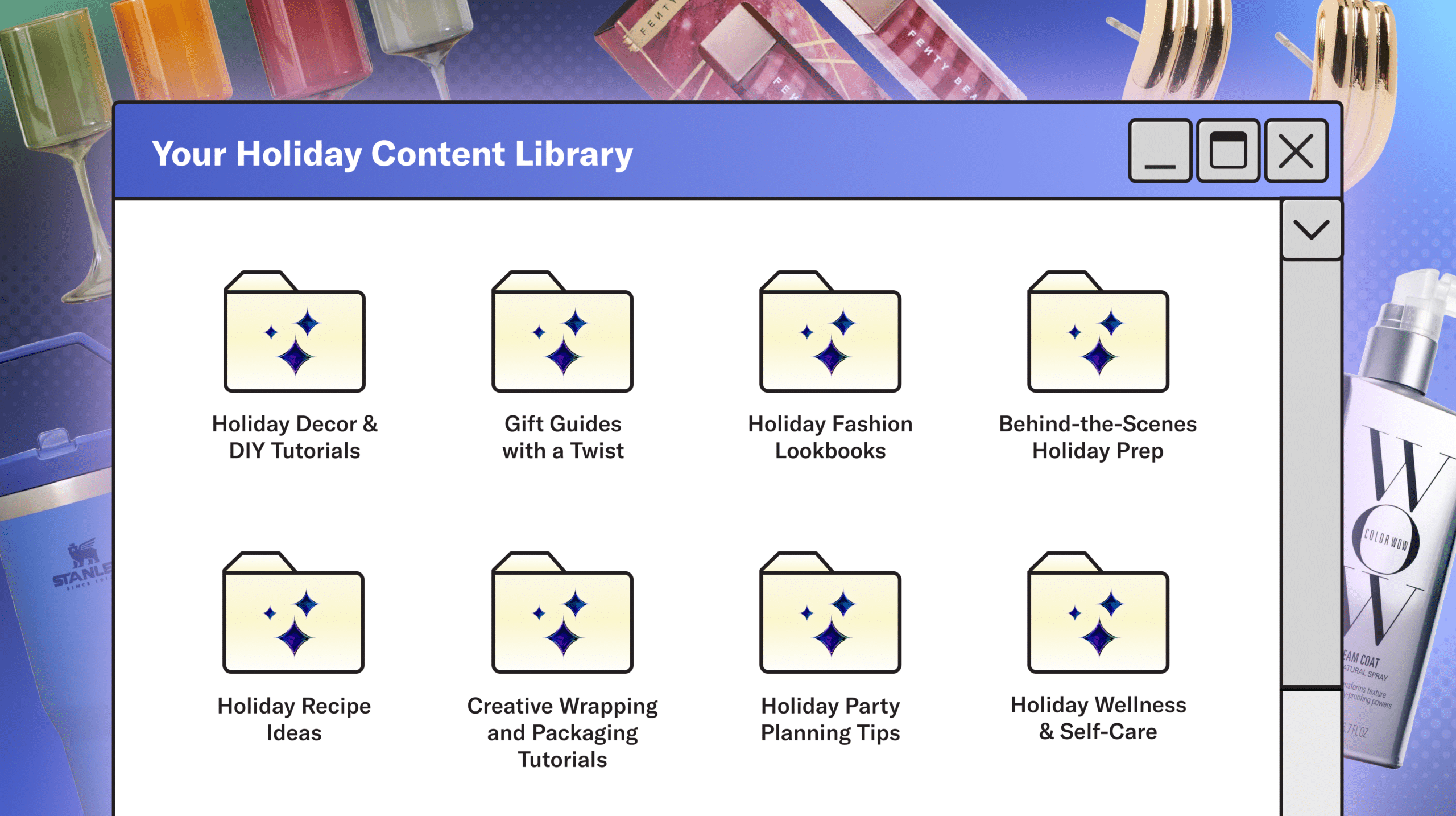Nurturing Creativity: Balancing Brand Guidelines and Creator Expression

With any Creator campaign, there’s a crucial balancing act for brands—preserving their brand identity while ensuring that Creators have the freedom to produce sincere content that resonates with their unique audiences.
Achieving this equilibrium between brand guidelines and Creator expression requires careful navigation.
Below, Collective Voice’s Director of Brand Partnerships, Amy Choi, answers eight questions about how brands can achieve this careful balancing act. She lays out practical strategies and considerations to help Marketers establish an environment where both brand consistency and creative freedom can thrive, ultimately leading to impactful and memorable campaigns.
How can Marketers strike a balance between preserving their brand guidelines and allowing Creators the freedom to express their unique creative styles?
These days, the best pieces of branded content are ones that feel and look authentic to the Creator who’s producing them. Which is why it’s so important for brands to be flexible about campaign guidelines!
But, there is also a time and place to be more strict about brand guidelines. Those times usually include how a product is being shown in-use, the accuracy of the brand and product information, and if there are any legal considerations around the sharing of this information and content that brands and Creators need to be aware of.
The key to striking the right balance is in allowing Creators to come up with their own creative concepts and choose their top platforms and content medium, while giving them detailed information to ensure the product and brand information they share is accurate. This way, brands can help Creators leverage the types of content that work best for them and resonate with their audience, while protecting their own brand image.
At Collective Voice, we make sure to have a “concepting phase” during the course of the campaign, so our client partners have an opportunity to get a sneak peek into Creators’ content ideas. This way, there’s alignment prior to the production and filming of content. This crucial step ensures everyone is on the same page, and brands can give the Creators feedback on how to incorporate brand guidelines into their content during the production process.
Are there times when creative freedom should take precedence over brand identity during a campaign? What about the other way around?
Every brand, product, and campaign is different, so there’s not a one-size-fits-all solution here.
For campaigns that center around creativity, expression, or a specific Creator, creative freedom should be key. For example, if the campaign is promoting a new makeup line that’s all about celebrating diversity, leaning into each Creator’s strengths and unique perspectives would help the campaign really shine.
But if the campaign deals with more sensitive topics or has specific legal parameters, then brand guidelines should be a stronger guiding force.
Are there specific industries or niches where it’s more challenging to strike the right balance between brand continuity and Creator authenticity? How can Marketers in those industries address these challenges?
Brands in regulated industries, such as pharmaceuticals, finance, or medicine, often require that sponsored content include specific disclosures and accurate product information that’s in compliance with laws and regulations.
Most Creators understand the necessity of these strict mandates and guidelines. Marketers in these industries can help Creators by making these types of guidelines and disclosures as easy and seamless to include in their content as possible. It’s not enough to just tell a Creator that they need to disclose information; tell them which information to disclose, how to disclose it, and where!
And any creative decision that can be left up to the Creator in this campaign, should be left to them so they’ll still have the opportunity to produce content that’s as authentic as possible.
How can brands approach the casting process to ensure this type of balance from the very beginning of the campaign?
Casting is an incredibly important factor in producing a campaign that’s both on-brand for a company and authentic to the Creators in the campaign. It’s really the first step towards ensuring this balance.
If a brand casts Creators who are not the right fit, there’s naturally going to be a disconnect between the Creators’ ability to “follow the guidelines” and their ability to produce content that feels natural for them. It’s a square peg, round hole debacle. For example, a makeup brand focusing on colorful, maximalist makeup looks probably wouldn’t cast a Creator who doesn’t wear makeup. The disconnect between the brand and Creator will be obvious to both audiences, hampering the potential success of this campaign.
Casting Creators from the get-go who align well with their brand identity ensures that there’s harmony between the authenticity of the brand and Creator.
What key factors should Marketers consider when selecting Creators whose content aligns with their brand’s values and aesthetic?
As a start, Marketers should look at Creators’ past content—not just their organic content, but also their sponsored content—to see how they’ve integrated brand partnerships into their content in the past.
Next, mapping out key traits of your brand and those of potential Creators could be beneficial when deciding if a Creator is a brand fit. As a Marketer, you want to ensure that the Creators you bring on as brand partners really align with your brand’s core values and mission as well. Beyond the “aesthetic,” there should be a deeper and intrinsic level of alignment that reinforces both the Creator and brand’s identities and shared values. When that happens, a successful authentic partnership can be formed.
How can brands adapt their creative briefs to encourage innovation and out-of-the-box thinking from Creators while maintaining a coherent brand image?
Being thorough and as detailed as possible is key in a creative brief.
If a brand is expecting something that’s “mandated,” being very clear up front will manage expectations from that Creator and also allow them to decide if this is something they can do or not do and ultimately, participate in the campaign.

In addition to creative briefs, what are some other processes brands can put in place to better collaborate and communicate with Creators?
A creative brief is just one tool that a brand has for communicating the expectations and guidelines of the campaign. But there are a few other ways that brands can get on the same page with Creators.
- Defer to them on platform, content type, and general concepts: Creators know what performs best for them; they know their top social platforms, the topics that resonate, and how their audience reacts. Make sure you give them the opportunity to select their top performing platforms, most successful content types (i.e., photo or video), and the general topics and concepts that fit best with their content.
- Give them content examples: Having concrete references to successful or inspirational Creator content helps Creators get a better sense of what you’re looking for. And it can give Creators a helpful starting point for ideating their concepts.
- Send Creators your brand guide: Provide Creators with a guide on your brand history and visual identity to give them more talking points and a clear understanding of the visuals and tone they should be aiming for.
- Give them detailed product specifications: Creators should speak authentically to how a product fits in with their lifestyle. And understanding all aspects of a product—the fabric, the construction, the R&D process—can give them a vocabulary for expressing what makes the product special.
- Make sure Creators understand your audience “personas”: Tell Creators about your brand “personas”—aka, the target audience you’re trying to reach in this campaign. That way, Creators have a better idea of why you’re interested in their audience, and who their content is speaking to.
- Set up a working session to discuss creative concepts: If Creators are struggling to come up with a concept that feels authentic to both their audience and your brand, set up a working session to discuss the concepts. You can give them a few broad ideas, or help them mold their concept so it feels authentic to the campaign and their audience.
- Be open to feedback: Ensure you have a forum to receive questions and feedback from Creators who need more clarity around brand guidelines.
Could you share examples of successful Creator Marketing campaigns where the balance between brand guidelines and Creator expression was exceptionally well-managed?
At Collective Voice, we are thrilled to also share we just won two awards—the Titan and Vega Awards for the Best Influencer Campaign—for our partnership with WayFair. For Wayfair’s key sale moment, also known as Way Day, we worked with a dynamic roster of home decor Creators who excel in both sales-driving and brand awareness, to promote the most relevant products to their audiences. We made a concerted effort to provide Creators with clear brand guidelines, while also giving them the freedom to express their own sense of style.
This strategy paid off in spades, and led to an impressive boost in social impressions and sales for Wayfair. And the content produced was truly the best of both worlds, as Creators highlighted the products and promotions in an on-brand manner for Wayfair, while showcasing their personal aesthetic within their home environment.
I also want to mention a campaign I saw during New York Fashion Week this September that, as a consumer, I thought was successful. Veronica Beard produced an exceptional campaign that not only perfectly balanced both the brand’s and Creators’ style, but also maintained a consistent visual aesthetic as a nod to their brand.
Creators styled their Veronica Beard looks in ways that were true to their own fashion sensibilities, but were given a “Veronica Beard branded newspaper” as a prop to be used in their content, creating this element of “branded consistency” across all the creators activated in the campaign. The brand also ensured that Creators posted their content at the same time, which created a groundswell of buzz for the brand. My Instagram feed was filled with inspiring images of Veronica Beard outfits! It was such a well done and executed campaign, and really stood out to me as an excellent example of how to preserve brand identity while fostering variety and creativity!




